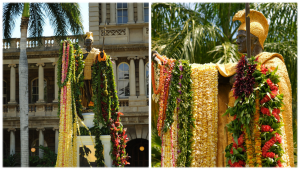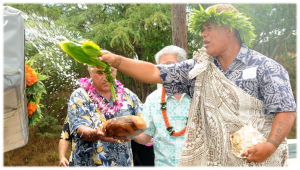 One of the things the residents of Hawai’i love most about our Island Home is the rich, multicultural traditions and customs. We share these customs with our friends, neighbors, and communities.
One of the things the residents of Hawai’i love most about our Island Home is the rich, multicultural traditions and customs. We share these customs with our friends, neighbors, and communities.
Whether it’s the 4th generation Japanese, making hand-made mochi for the New Year, or the Dragon Dance for the Chinese New Year, there are dozens of customs in Hawai’i. Each one comes from ancient traditions and is a grand opportunity for a celebration and fun!
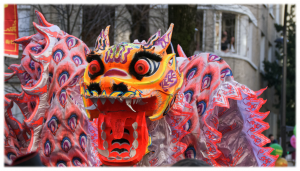 People everywhere have unique customs and traditions; things they look forward to during certain times of the year or season. It is a big part of being human and part of a society or culture. One of the most essential contributions each culture can make to our global village is its own, very unique version of life. Their customs have been passed down through generations.
People everywhere have unique customs and traditions; things they look forward to during certain times of the year or season. It is a big part of being human and part of a society or culture. One of the most essential contributions each culture can make to our global village is its own, very unique version of life. Their customs have been passed down through generations.
Customs in Hawai’i come from a large variety of cultures.
Besides Hawaiian customs, there are Chinese, Portuguese, Japanese, Korean, Puerto Rican, Okinawan, Filipino, and European-descent traditions, which we ALL love to be part of and entertained by!
In 1850 Chinese immigrants arrived to work in the sugar cane fields. Since then, the Aloha State has had a long history of attracting people from other parts of the world. And all of these different nationalities and races brought their own very unique culture and customs with them.
This is why our islands are blessed with such a rich and varied extravaganza of traditions!
One custom most visitors never experience is the significant custom of the “Baby Lūʻau.” This nickname represents the extensive celebration marking the first birthday of the newborn. This was a meaningful ceremony in Hawai’i for centuries. They had learned, over time, that if the baby lived to see one full circle around the sun, they had a high chance of living a full life. Expressing gratitude, relief, excitement, and honor, these large-scale festivities, pull out all the stops and have the very best of everything. Food, music, and of course, hula.
The new custom of having your best friend officiate your wedding has recently exploded across social media. This caught on because it fits perfectly with the culture of the younger generation having the majority of marriages.
And of course, technology is continuously adding new customs. For example, how and when to text, and when to make a REAL phone call (basically never, unless either you or someone near you needs help!).
Experiencing and immersing ourselves in the customs of others is one of the real joys of traveling.
And, learning a bit of the language, the culture, and the deeply rooted traditions before visiting a place like Hawai’i can make you feel more of a part of it. When you visit again, you will feel more like you are coming home.
Hawaiian customs have become part of the fabric of life for both long-term residents and Native Hawaiians alike. Let’s discover a few customs of the State of Hawai’i and learn a little more about this vibrant, multicultural land of beauty.
5 Hawaiian Customs
Giving or Receiving Lei
If someone presents you with a lei, they’re wishing you a happy life. It is an unspoken expression of Aloha. The meaning behind it is this: the flower lei may last for only a brief moment in time, but the sentiment behind it lasts forever.
For this reason, you should accept it and wear it with gratitude. And most certainly, never remove it in the presence of the person who gave it. If it irritates your neck, you can center it on your shoulders so that it will rest on your clothes rather than resting on the skin of your neck.
An expectant mother will be given an open-ended lei that is intended to encourage a safe delivery. If you are allergic to flowers or plants, it is best to apologize that you are unable to accept and explain the situation and thank them for their thoughtfulness.
Lei giving or receiving is probably the most enjoyable and unforgettable Hawaiian custom.
It has been a special treat for those who arrive or depart by plane or ship for decades. For those visiting, it is an extra warm Aloha of welcome and for those leaving, it is a farewell, until we meet again.
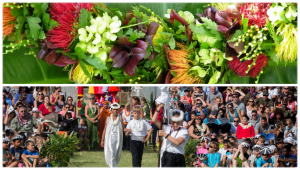
Lei Day is a statewide celebration of Hawaiian culture and the Aloha Spirit. It begins on the morning of May first every year and continues into the next day. Lei Day was established as a holiday in 1929. It has been celebrated ever since with an overflowing abundance of Lei.
Each island has a particular style of Lei that they are represented by.
Lei Day celebrations were first held in the Royal Courts (remember, Hawai’i had a Monarchy) and then in the Town Halls.
Some islands may have a celebration in a park, quite often with a statue of King Kamehameha the First also decked out in lei. All Elementary Schools put on a production that includes electing Lei Day Court Kings and Queens to represent each of the islands. These young Kings and Queens wear the color and lei style particular to each island they are representing, and their class will bring the gift of hula to “their King and Queen” of a song they have chosen for the island they are representing.
The Hawaiian Blessing
The Hawaiian Blessing Ceremony goes back to the early days in Hawai’i. After the arrival of missionaries in 1820, it began to incorporate more Christian elements.
The specifics of a Hawaiian Blessing Ceremony can differ depending on what the blessing is for.
Generally, these days it is for the opening of a new business, the completion of a building, the ceremony before the housewarming party, or any other newly opened establishment. It can also be for a groundbreaking or if someone feels the need to bless a specific place for any reason. Perhaps, as in the old Hawaiian tradition, asking the different gods and goddesses for their guidance and blessing while also expressing gratitude.
A Hawaiian Kahu* is called upon to give the blessing. The blessing, based on the traditional Hawaiian belief of kapu*, is used to remove something disturbing that has arisen or has been called down upon a place. Things such as negative energy or curses. The notion is to cleanse or heal the space so that the new occupants can start afresh. Sometimes, the Kahu will simply ask for forgiveness for some egregious insult to the gods or the ancestors. An example of this can be when bones are disturbed during a construction building project.
The Kahu personalizes blessings specifically for the occasion.
He or she will speak, choose a reading, or chant something that is suited to the place they will bless.
Three elements are included in this blessing: the asking for blessings from Akua*, the sprinkling of salt water, and the untying of a Maile Lei* that may be gently draped in an appropriate area.
Once the ceremony is over, the kapu are amama*.
It is meaningful to learn to use the words aloha* and mahalo* with sincerity.
Although Aloha (pronounced “ah lo hah”) has many meanings, you will mostly use it for greeting a person or saying goodbye. Mahalo (pronounced “muh hah lo”) means thank you.
These beautiful words will enhance your love affair with the islands.
Since most towns and streets have Hawaiian names, if you become familiar with basic pronunciation, you will be able to practice your Hawaiian by saying their names.
On a side note, aloha not only means hello, goodbye, and love, but it also implies sympathy, kindness, compassion, affection, and fondness. This word, whose primary and most used meaning is a greeting, is considered one of the Hawaiian culture’s core values.
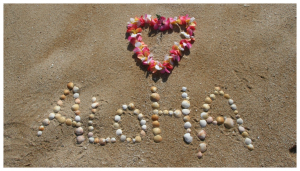
Isolated and luscious, the islands of Hawai‘i are the most isolated landmass in the world. Hawai’i is one of the most idyllic and popular vacation spots on the planet. But it is much more than just that! It is the land and sea which gives the gift of life to her people.
Therefore, it is essential to remember this custom: take care of the land and the sea.
Ancient Hawaiians saw the land and oceans as givers of life and aspired to treat them with due reverence because of this incredible gift.
Visitors to Hawai‘i can honor that cultural legacy in meaningful ways by maintaining that reverence. By picking up your opala* and leaving a place better than you found it. These simple acts of taking care of the environment are honoring this home of the native people. And, most importantly, honoring the spirit of Aloha, which is the core value and custom upon which the entire culture is founded.
The Hawaiian culture is well known for its signature musical sound, its Hula dance, and its warriors, defending their islands from invaders. Still, during the day-to-day life that we all live on these islands, the Hawaiian culture is mostly recognized for its compassion, affection, and humility. Especially treating the elders with respect and love as an example to the young ones. Speaking with a soft voice, like the sweet calls of the native birds.
Being gentle, considerate, and kind, you are honoring Hawai’i and Hawaiians with one of the customs they treasure most – the Aloha Spirit.
Writing and graphic creation by Sugandha Ferro Black
GLOSSARY* of Hawaiian Words
Aloha – Greeting of hello or farewell, love, caring
‘Aina – the land
Amama – Done, finished, gone
Kahu – minister, priest
Kapu – forbidden, taboo, off-limits,
Mahalo – Thank you
Maile Lei – very special lei made from the leaves of a fragrant, native twining shrub growing deep in the forest
Opala – garbage, trash
*Please keep in mind that all Hawaiian Words have many meanings. The meanings we share here are the specific translations for the words as they pertain to this particular blog’s subject matter.
Photos courtesy of paid-for or free sources unless otherwise noted.

